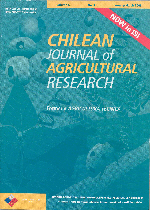
|
Agricultura Técnica
Instituto de Investigaciones Agropecuarias, INIA
ISSN: 0365-2807
EISSN: 0365-2807
Vol. 61, No. 4, 2001, pp. 444-451
|
 Bioline Code: at01046
Bioline Code: at01046
Full paper language: Spanish
Document type: Research Article
Document available free of charge
|
|
|
Agricultura Técnica, Vol. 61, No. 4, 2001, pp. 444-451
| en |
Comparison of Wheat and Maize Silage in Winter Finishing of Steers
Rojas, Claudio G. & Manríquez, Moisés B.
Abstract
During 72 days of
the winter season of 1998, twenty-four Normando steers, 20 to 21 months of age
and 385 kg average liveweight, were fattened in order to evaluate animal response
to feeding of whole wheat (Triticum aestivum L.) silage in
comparison to maize (Zea mays L.) silage. Treatments were T1:
maize silage; T2: wheat silage at milky starchy stage; and T3: wheat silage at
soft or hard starchy stage. The feed was composed of a mixture of silage and concentrates
in a 62.5: 37.5 ratio, respectively. The concentrates were formulated with oats
(Avena sativa L.) and white lupines (Lupinus albus
L.), urea and minerals in order to obtain an approximately isoproteic ration with
13% crude protein. The experimental design was a completely randomized block with
8 replicates. The feed consumption and daily liveweight gains of T3 were significantly
higher (P≤0.05) than T1 and T2. Feed conversion efficiency and dressing
percent were not statically different due to the treatments (P≥ 0.05).
It was concluded that wheat silage, especially at the soft or hard starchy stage,
can replace maize silage on rations for fattening steers without affecting weight
gains.
Keywords
wheat silage, maize silage, steers, liveweight
|
| |
| es |
Comparación de Ensilaje de Trigo y de Maíz en la Engorda Invernal de Novillos
Rojas, Claudio G. & Manríquez, Moisés B.
Resumen
Durante 72 días de la temporada invernal
de 1998, se utilizaron 24 novillos Normando de 20 a 21 meses de edad y 385 kg
de peso vivo (PV) promedio, con el objetivo de evaluar la respuesta animal al
consumo de ensilaje de trigo (Triticum aestivum L.) cosechado
en dos estados vegetativos, en comparación a ensilaje de maíz (Zea
mays L.). Los tratamientos fueron T1: ensilaje de maíz; T2: ensilaje
de trigo grano lechoso harinoso; y T3: ensilaje de trigo grano harinoso suave
a duro. La alimentación estuvo constituída por la mezcla de ensilaje
con concentrados, en la relación 62,5: 37,5, respectivamente. Los concentrados
se formularon para cada ensilaje, con grano de avena (Avena sativa
L.), lupino blanco (Lupinus albus L.), urea y sales minerales,
de forma que la oferta de alimentos fuera aproximadamente isoproteica para niveles
de 13%. El diseño experimental fue de bloques completos al azar, con 8 repeticiones.
El consumo de alimentos y los incrementos de PV del T3 fueron significativamente
mayores (P ≤0,05) al T1 y T2. La eficiencia de conversión del alimento
y el rendimiento centesimal de las canales en caliente no presentaron diferencias
debidas a tratamientos (P ≥0,05). Se concluye que el ensilaje de trigo,
especialmente en el estado de grano harinoso suave a duro, puede reemplazar al
ensilaje de maíz, con menos de 30% de MS, en raciones de engorda de novillos,
sin afectar los incrementos de PV.
Palabras-clave
ensilaje de trigo, incremento de peso, ensilaje de maíz
|
| |
© Copyright 2001 - Instituto de Investigaciones Agropecuarias, INIA (Chile)
Alternative site location: http://www.inia.cl/at/agritec.htm
|
|
